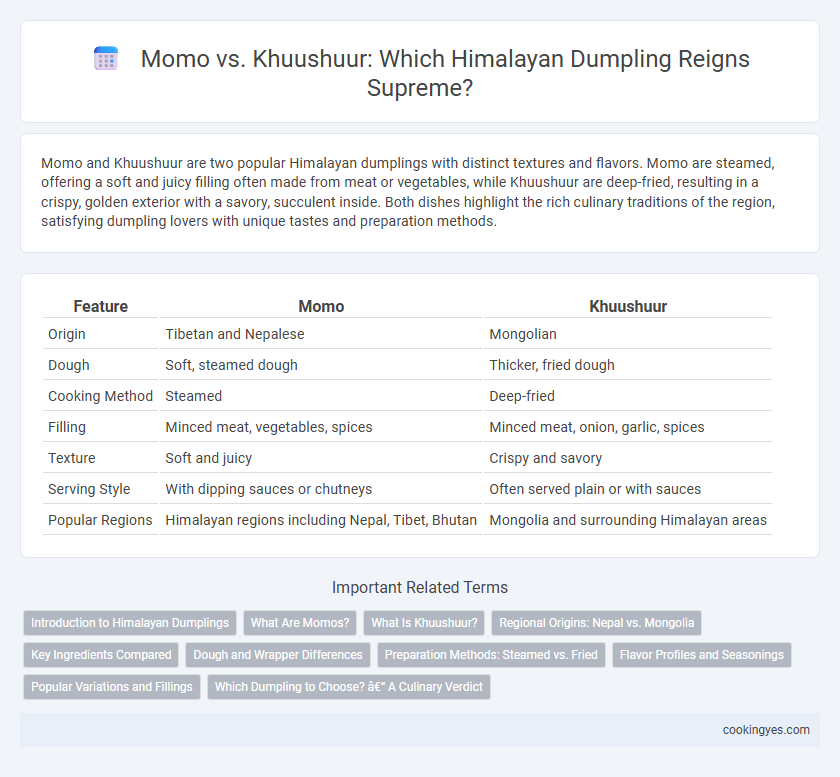Momo and Khuushuur are two popular Himalayan dumplings with distinct textures and flavors. Momo are steamed, offering a soft and juicy filling often made from meat or vegetables, while Khuushuur are deep-fried, resulting in a crispy, golden exterior with a savory, succulent inside. Both dishes highlight the rich culinary traditions of the region, satisfying dumpling lovers with unique tastes and preparation methods.
Table of Comparison
| Feature | Momo | Khuushuur |
|---|---|---|
| Origin | Tibetan and Nepalese | Mongolian |
| Dough | Soft, steamed dough | Thicker, fried dough |
| Cooking Method | Steamed | Deep-fried |
| Filling | Minced meat, vegetables, spices | Minced meat, onion, garlic, spices |
| Texture | Soft and juicy | Crispy and savory |
| Serving Style | With dipping sauces or chutneys | Often served plain or with sauces |
| Popular Regions | Himalayan regions including Nepal, Tibet, Bhutan | Mongolia and surrounding Himalayan areas |
Introduction to Himalayan Dumplings
Himalayan dumplings are a culinary staple across regions like Nepal, Tibet, and Mongolia, with momo and khuushuur being two popular varieties. Momo, often steamed or fried, features a thin dough wrapper filled with spiced meat or vegetables, highlighting Nepalese and Tibetan flavors. In contrast, khuushuur is a deep-fried Mongolian dumpling with a thicker crust and savory meat filling, offering a crispy texture unique to Mongolian cuisine.
What Are Momos?
Momos are traditional Himalayan dumplings originating from Tibet and Nepal, typically filled with spiced meat or vegetables and steamed to retain their juicy texture. Unlike Khuushuur, which are deep-fried and have a crispy exterior, Momos boast a soft, chewy dough that enhances the savory flavor of their fillings. Their versatility and distinct steaming method make Momos a staple in Himalayan cuisine, celebrated for their harmonious blend of spices and tender bite.
What Is Khuushuur?
Khuushuur is a traditional Mongolian fried dumpling known for its crispy exterior and juicy meat filling, typically made with beef or mutton mixed with onions and garlic. Unlike momos, which are usually steamed and originated from Tibetan and Nepali cuisines, khuushuur is pan-fried to achieve a golden-brown crust that enhances its savory flavors. This unique cooking method gives khuushuur a distinct texture and taste, making it a popular street food across Mongolia and the Himalayan region.
Regional Origins: Nepal vs. Mongolia
Momo, a staple Himalayan dumpling, originates from Nepal and features a soft steamed dough filled with spiced meat or vegetables, reflecting Nepali culinary traditions influenced by Tibetan culture. Khuushuur, hailing from Mongolia, is a deep-fried meat-filled dumpling known for its crispy exterior and juicy interior, embodying Mongolian nomadic flavors and ingredients. The primary regional distinction lies in momo's steamed preparation linked to Nepalese high-altitude cooking, while khuushuur's fried method suits Mongolia's pastoral lifestyle and climate.
Key Ingredients Compared
Momo, a popular Himalayan dumpling, is traditionally filled with ground meat such as yak, beef, or chicken mixed with garlic, ginger, onions, and cilantro, offering a savory and aromatic profile. Khuushuur, typical to Mongolian cuisine but also enjoyed in parts of the Himalayas, features a meat filling often made from minced mutton or beef combined with finely chopped onions and simple seasoning like salt and pepper. While momos typically incorporate a wider array of spices and herbs for a layered flavor, khuushuur emphasizes a straightforward, hearty meat taste with a crisp fried exterior.
Dough and Wrapper Differences
Momo dough is typically made from all-purpose flour and water, resulting in a smooth, elastic wrapper that holds delicate fillings and steams evenly. Khuushuur dough uses a thicker, oil-enriched flour mixture, creating a crispy, fried wrapper with a chewy texture distinct to Mongolian cuisine. The fundamental difference lies in momo's soft, pliable wrapper suited for steaming, while khuushuur's dough is robust and designed to withstand deep frying.
Preparation Methods: Steamed vs. Fried
Momo dumplings are traditionally prepared by steaming, which preserves their soft texture and delicate flavors, commonly using a thin wheat flour wrapper filled with spiced meat or vegetables. In contrast, Khuushuur are pan-fried or deep-fried, resulting in a crispy, golden-brown exterior and a richer taste due to the Maillard reaction during frying. The choice between steamed Momo and fried Khuushuur reflects distinct culinary techniques in Himalayan regions, influencing texture, flavor, and overall eating experience.
Flavor Profiles and Seasonings
Momo dumplings feature a delicate blend of garlic, ginger, and cilantro, creating a savory and aromatic flavor profile typical of Tibetan and Nepali cuisine. Khuushuur, a Mongolian fried dumpling, boasts a richer and heartier taste with ground meat seasoned with cumin, onion, and black pepper, offering a spiced and smoky dimension. Both dumplings highlight regional seasonings, with momo emphasizing fresh herbs and light spices, while khuushuur relies on bold, robust seasoning for its distinctive flavor.
Popular Variations and Fillings
Momo and Khuushuur are popular Himalayan dumplings with distinct variations and fillings. Momo typically features steamed dough stuffed with minced meat like yak, pork, or chicken, combined with finely chopped vegetables and aromatic spices. Khuushuur is a deep-fried dumpling often filled with ground mutton or beef, mixed with onions, garlic, and cumin, offering a crispy texture and rich flavor unique to Mongolian and Tibetan cuisines.
Which Dumpling to Choose? – A Culinary Verdict
Momo and Khuushuur are two iconic Himalayan dumplings, each offering distinct textures and flavors that cater to different palates. Momo, typically steamed, features a soft, juicy filling that highlights fresh, aromatic spices, ideal for those seeking a lighter, more delicate dumpling experience. Khuushuur, on the other hand, is deep-fried to achieve a crispy, golden exterior with a richly savory, meaty interior, making it the preferred choice for diners craving hearty, bold flavors.
Momo vs Khuushuur for Himalayan dumplings Infographic

 cookingyes.com
cookingyes.com